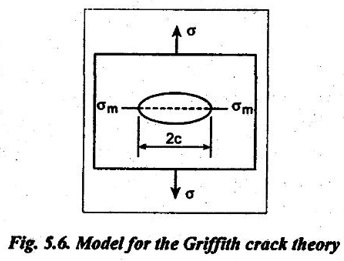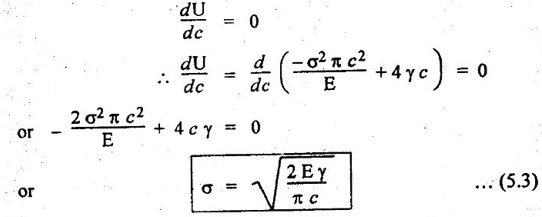A brittle fracture may be defined as a fracture which takes place by the rapid propagation of crack with a negligible deformation.
BRITTLE FRACTURE
1. What is Meant by Brittle Fracture?
✔ Brittle fracture defined: A brittle fracture may be defined as a fracture which takes place by the rapid propagation of crack with a negligible deformation.
✔ It may be noted that in amorphous materials such as glass, the fracture is completely brittle whereas in crystalline materials, the fracture occurs after a small deformation.
✔ In crystalline materials, the fracture takes place normal to the specific crystallographic planes, called cleavage planes.
✔ In polycrystalline materials, the fracture takes place along the grain boundaries.
✔ The tendency of the brittle fracture is increased with decreasing temperature and increasing strain rate.
2. Mechanism of Brittle Fracture: Griffith's Theory (Griffith Crack Theory)
1. Introduction
It is proved that the stress at which a material fractures is far below the lower value of the ideal breaking strength calculated from the atomic strength. In other words, the fracture strength of real materials is far lower than (about 104 MPa) the theoretical minimum value for an ideal solid.
According to Griffith, the discrepancy between the strengths of real and ideal materials is due to many fine cracks which act to concentrate the stress at their tips or ends.
2. Griffith Theory
Griffith's postulation is as follows:
1. In a brittle material, there are many fine cracks. These cracks concentrate the applied stress at their tips or ends.
2. When the stress at the tips of a crack exceeds the theoretical stress values, the crack expands and fracture occurs.
3. Explanation of Mechanism of Brittle Fracture
Let us consider a crack of elliptical cross-section in a rectangular specimen as shown in Fig.5.6.

Let
σ = Tensile stress applied to the specimen,
σm = Maximum stress at the tip of the crack,
c = Half length of the crack, and
ρ = Radius of curvature at the ends of the ellipse.
It is observed that when a tensile stress is applied to the specimen, then the applied stress is distributed about the crack in such a way that the maximum stress occurs at its tips. The maximum stress (σm) at the tip of the crack is given by

It is understood that when an elastic material is stressed, potential energy is stored in the material before crack occurs. This stored energy is known as elastic strain energy. When a crack begins propagating, elastic energy is released.
It is also understood that as the crack propagates, new surfaces are created and a certain amount of energy, called surface energy, must be provided to create them.
4. Derivation for Fracture Strength
Griffith supposed that the crack propagates when the released strain energy is just sufficient to provide the surface energy necessary for the creation of the new surface.
According to elastic theory,
The strain energy per unit volume = σ2 / 2 E
where
E = Young's modulus of the material.
Then the elastic strain energy released by the spreading of a crack of unit width is given by,

A more detailed calculation shows that the strain-free volume is larger and the elastic energy released will be twice the value given in equation (i). Then equation (i) becomes,

The negative sign indicates that the elastic energy stored in the material is released as the crack forms.
If γ = Surface energy per unit area in joules/m2, then the surface energy (Us) for a crack of length 2 c with unit width is given by
Us = 4 γ c ... (iii)
Since there are two surfaces, the equation (iii) is multiplied by two.
The total change in potential energy, resulting from the creation of the crack, is given by,

According to Griffith, the crack will propagate and produce brittle fracture when an incremental increase in its length does not change the total energy of the system. Mathematically,

The above equation is called Griffith's fracture equation.
5. Observations
From equation (5.3), the following observations can be made :
(i) The stress necessary to cause brittle fracture varies inversely as the square root of the crack length.
(ii) The critical tensile stress required to propagate the crack spontaneously is smaller than the Young's modulus of the material.
(iii) The Griffith theory is valid only for a perfect brittle material like glass.
No comments:
Post a Comment